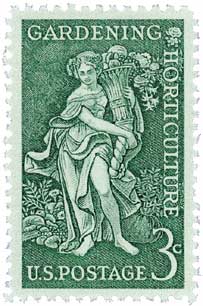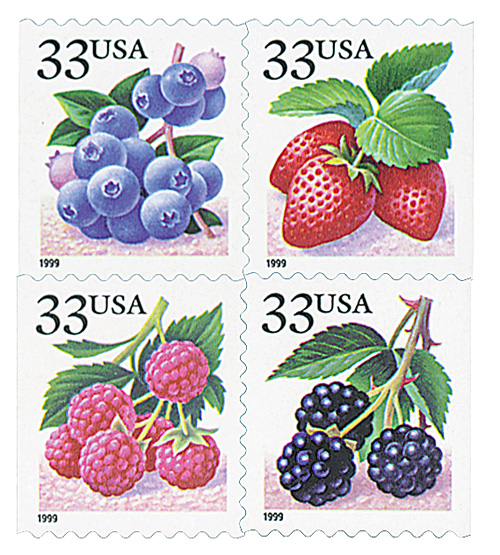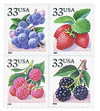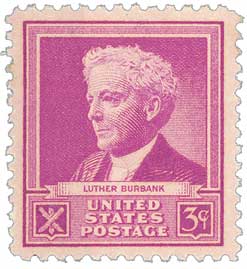
# 3298-3301 - 1999 33c Fruit Berries, booklet stamps
1999 33¢ Four Fruit Berries
Flora and Fauna
City: Ponchatoula, LA
Quantity: 1,200,000,000
Birth Of Luther Burbank
The thirteenth of eighteen children, Burbank spent his childhood on his family farm enjoying his mother’s large garden. He only received a high school education but would go on to become a pioneer in agricultural science.

Following his father’s death, Burbank used his inheritance to buy 17 acres of land near Lundenburg. There he developed the Burbank potato and sold the rights to it for $150. He then used that money to travel to Santa Rosa, California, in 1875. The Burbank potato was later renamed the Russet Burbank potato and became one of the most widely used potatoes for food processing, such as for French fries.
After moving to California, Burbank bought four acres of land and set up a greenhouse, nursery, and experimental fields. He used these fields to experiment with crossbreeding after reading Charles Darwin’s The Variation of Animals and Plants under Domestication. He later expanded his plot by another 18 acres.

In the coming years, Burbank began producing popular plant catalogs, most notably his 1893 “New Creations in Fruits and Flowers.” Around this same time, Burbank met Clarence McDowell Stark, of Stark Bro’s Nurseries & Orchards. At the time, Burbank was running a small seed and nursery business to make ends meet, distracting him from his brilliant work in hybridizing. Stark believed he was wasting his time with the nursery business so he offered him $9,000 for three varieties of fruits.
Burbank also had fans, The Luther Burbank Society, which worked to publish his discoveries and manage his business dealings to help him out financially. Additionally, from 1904 through 1909, the Carnegie Institution gave Burbank several grants to fund his research. Andrew Carnegie was a strong supporter of Burbank.
Click here to read more about some of Burbank’s plants.
1999 33¢ Four Fruit Berries
Flora and Fauna
City: Ponchatoula, LA
Quantity: 1,200,000,000
Birth Of Luther Burbank
The thirteenth of eighteen children, Burbank spent his childhood on his family farm enjoying his mother’s large garden. He only received a high school education but would go on to become a pioneer in agricultural science.

Following his father’s death, Burbank used his inheritance to buy 17 acres of land near Lundenburg. There he developed the Burbank potato and sold the rights to it for $150. He then used that money to travel to Santa Rosa, California, in 1875. The Burbank potato was later renamed the Russet Burbank potato and became one of the most widely used potatoes for food processing, such as for French fries.
After moving to California, Burbank bought four acres of land and set up a greenhouse, nursery, and experimental fields. He used these fields to experiment with crossbreeding after reading Charles Darwin’s The Variation of Animals and Plants under Domestication. He later expanded his plot by another 18 acres.

In the coming years, Burbank began producing popular plant catalogs, most notably his 1893 “New Creations in Fruits and Flowers.” Around this same time, Burbank met Clarence McDowell Stark, of Stark Bro’s Nurseries & Orchards. At the time, Burbank was running a small seed and nursery business to make ends meet, distracting him from his brilliant work in hybridizing. Stark believed he was wasting his time with the nursery business so he offered him $9,000 for three varieties of fruits.
Burbank also had fans, The Luther Burbank Society, which worked to publish his discoveries and manage his business dealings to help him out financially. Additionally, from 1904 through 1909, the Carnegie Institution gave Burbank several grants to fund his research. Andrew Carnegie was a strong supporter of Burbank.
Click here to read more about some of Burbank’s plants.












